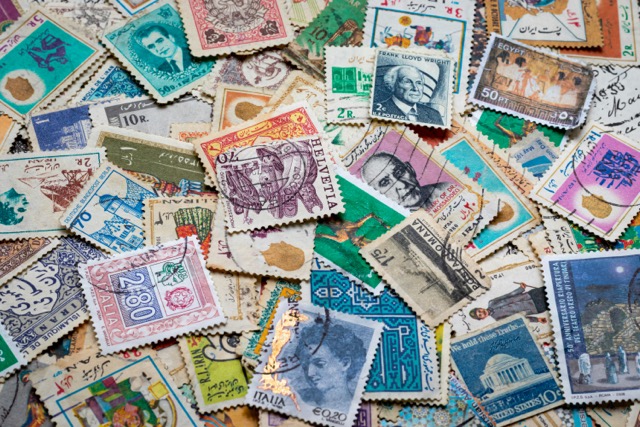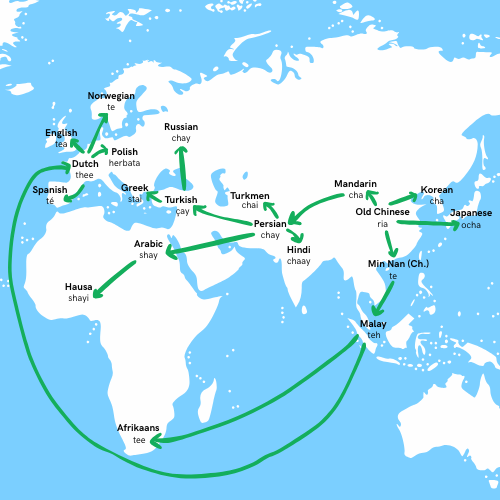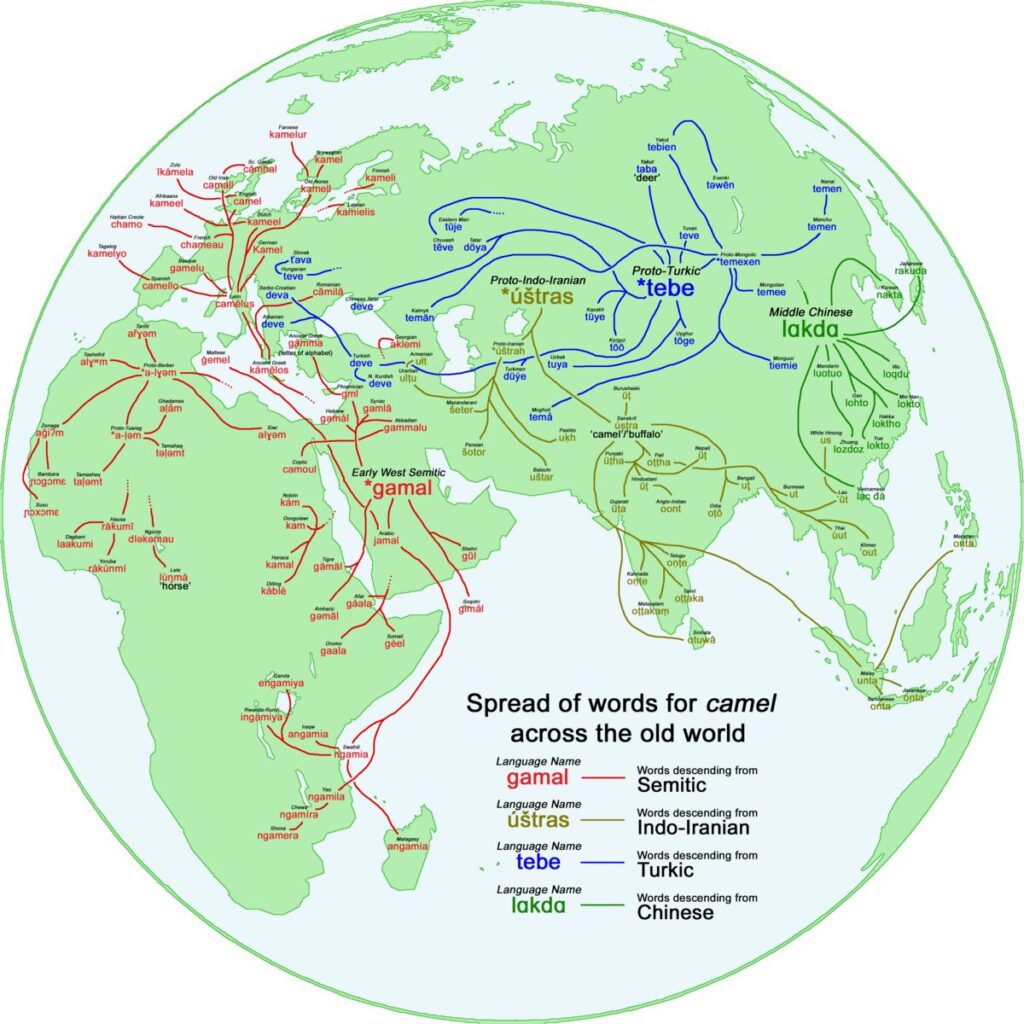
Summer. A time for suitcases, maps and departures. The world is on the move. Humans aren’t the only ones taking off, words travel too.
Some words have been on the move for centuries, crossing mountains, deserts and oceans, changing shape, and picking up new inflections. They’re wanderwörter, words that migrate, blend and adapt, becoming witnesses to cultural and human experience and connection. We’ve tracked a few across languages and eras. Ready to travel with us?
What Are Wanderwörter: Nomads of Vocabulary
A Wanderwort ([ˈvandɐvɔʁt], German for “wandering word”) is a word that shows up in completely different languages around the world, even when those languages aren’t connected. These words don’t just appear by chance. They’ve traveled through trade, conversation, and cultural exchange. Along the way, they settle into new languages, picking up local sounds while holding onto a hint of where they came from.
Picture a medieval marketplace: a Chinese merchant shows off spices to a Persian trader, who later sells them to a Venetian lord. Along with the goods, their product names travel. That’s how these wandering words are born, passed from mouth to mouth, shaped by each new tongue, yet always holding a common thread back to where they came from. That’s why words like “sugar” and “ginger” sound surprisingly familiar in many parts of the world: their names have traveled just as far as the goods themselves.
Tea’s Two Pathways

Even if you’ve never left your city, you’ve probably read “chai” on a café chalkboard or heard “çay” in a film set in Istanbul. Those are all the same drink,
tea, but the word took two different linguistic paths, shaped by how the tea itself traveled around the world to become the global phenomenon it is today:
- By sea: From the Old Chinese, the word te reached Dutch merchants, where it became thee, and spread across Europe as thé in French, té in Spanish and Italian, and tea in English.
- By land: From Mandarin or Cantonese cha, it traveled the Silk Road through Central Asia, evolving into chaay in Hindi and chāy in Persian.
Next time you order a matcha at a trendy cafè or a “chai latte” to go, remember that you’re not just enjoying a drink. You’re part of a linguistic journey that began thousands of years ago
Ginger and Its Linguistic Roots
Ginger, as all roots do, clings to any fertile soil. Tough and knotted, its name has taken root across the globe. Originating from the Sanskrit śṛṅgavera (“horn-shaped root”), the word became zanjabīl in Persian and Arabic. As it made its way to Europe, it turned into gingiber in Medieval Latin, then gingembre in French, and finally ginger in English.
The original “z-n-b-l” phonetic backbone stays surprisingly consistent, like ginger’s unmistakable flavor, which blends into every local cuisine while retaining its bite.
Sugar: Sweetness That Unites Continents
Like sugarcane crushed and refined into crystals, the word śarkarā was processed linguistically through every culture it touched. Stemming from the Sanskrit, the Persians softened it into shakar, the Arabs crystallized it into sukkar, and Europe gave us sucre, zucchero, and
sugar.
The core “s-k-r” structure remains as a sweet thread running through every language, linking ancient trade to modern treats, from Sunday cakes to a shot of espresso.
The Camel: A Timeless Traveler

The word camel is the result of an ancient journey, one that winds through deserts, empires, and trade routes. Slow but resilient, it has left its footprints in sand, in language, and in the story of civilization
From Bedouin Tents to Roman Markets
Picture a desert sunset. A Bedouin rests beside his gamal. That same companion is called jamal in Arabic. In its earliest form, the word meant “carrier” or “reward.” From there, it changed into Greek as kamēlos, then Latin camelus. Lastly, Romance languages: the Italian cammello, the French chameau, the Spanish camello, and the English camel.
Parallel Routes: The Caucasus
Beyond the Mediterranean path, there’s evidence of a parallel route through the Caucasus. Languages like Georgian (aklemi) and Chechen (emkal) carry similar-sounding variants, hinting at an ancient transmission along Central Asian trade corridors.
When East Meets West
Even Chinese preserved traces of this nomadic word. In Middle Chinese, we find forms like lak.da and thak.da, likely borrowed from Indo-Iranian or Turkic languages via Tocharian intermediaries. In modern Korean, you’ll still hear nakta (even though camels themselves are long gone from the region).
Like the camel itself, the word has adapted to every climate and terrain, yet it never lost its enduring nature.
Why We Love Wanderwörter: A World Inside a Word
Wanderwörter are echoes of ancient globalization. The discovery of a new flavor, a new product or experience. Every time we use them, we’re recalling a meeting between cultures, a shared moment in the history of languages. These words are bridges, between places, between people, and each one holds a hidden map of its travels.
Whether you are a spice trader on the Silk Road or a tourist picking up a new phrase. You carry words, passed on from someone who welcomed you into their world.
Wanderwörter for Modern Business
Products and words love to travel. Like tea, ginger, and camel, they cross borders, adapt to new cultures, and carry their story with them.
At Maka, we make that journey easier, helping your products and your words reach new markets through multilingual expert e-commerce
localization and cultural adaptation to connect with people everywhere.
About author
Marketing Specialist @ Maka Language Consulting

 Even if you’ve never left your city, you’ve probably read “chai” on a café chalkboard or heard “çay” in a film set in Istanbul. Those are all the same drink, tea, but the word took two different linguistic paths, shaped by how the tea itself traveled around the world to become the global phenomenon it is today:
Even if you’ve never left your city, you’ve probably read “chai” on a café chalkboard or heard “çay” in a film set in Istanbul. Those are all the same drink, tea, but the word took two different linguistic paths, shaped by how the tea itself traveled around the world to become the global phenomenon it is today:


